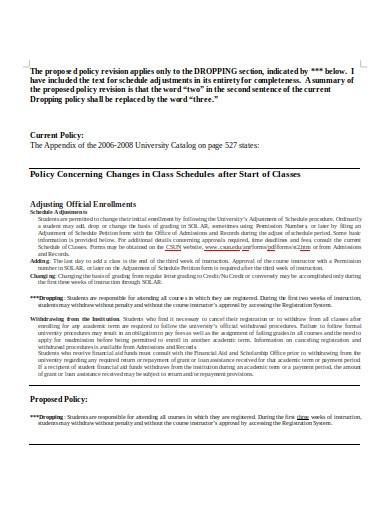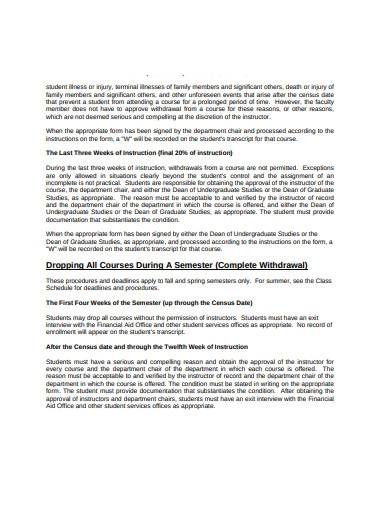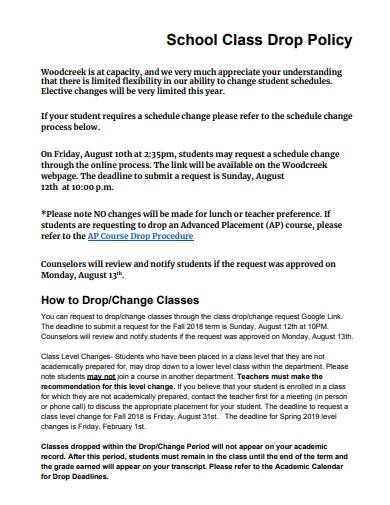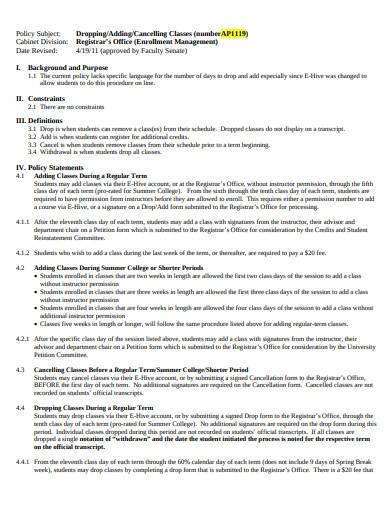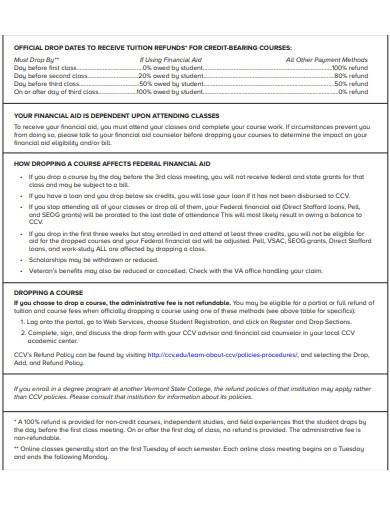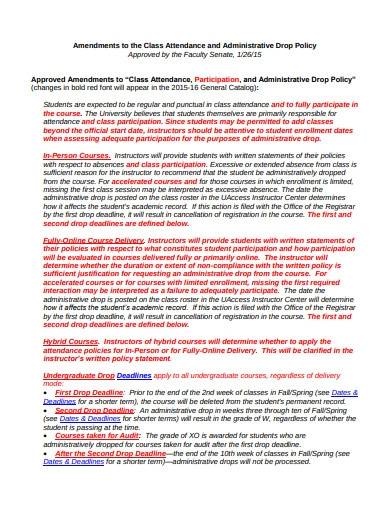Every college or university has a set of policies solely intended for adding and dropping classes. It’s pretty common, especially to students who have irregular class schedules and those who need to catch up with some subjects. For the transaction to go smoothly, all students are required to follow the school’s dropping classes policy. Since it’s a commonplace, the need for a standard policy is necessary. In this article, you will find downloadable dropping classes policy samples that will help you get familiar with the different document styles and formats. You’ll also get to learn more about adding/dropping policies with the FAQs provided below.
FREE 10+ Dropping Classes Policy Samples & Templates
1. Dropping Classes Policy Template
2. Sample Dropping Classes Policy
3. Students Adding and Dropping Classes Policy
4. Dropping Classes Aid Policy
5. Sample School Class Drop Policy
6. Sample Drop Policy Template
7. Dropping Cancelling Classes Policy
8. Policy and Procedure on Dropping Classes
9. Dropping Classes Policy and Procedures Sample
10. Formal Dropping Classes Policy
11. Attendance and Administrative Drop Policy
What Is a Dropping Classes Policy?
Dropping classes means removing a course or two from a specific schedule. Because this is usually practiced in different colleges and universities, they have made it a point to have a dropping class policy. Students who wish to add or drop a particular class will need to follow the guidelines in the policy template. A dropping class policy helps establish a standard procedure that students must follow for the sake of uniformity. The reasons for adding or dropping classes include signing up for too many courses, change in future college major, going for a more advanced subject, need to reduce course load, etc.
How To Make a Dropping Classes Policy
Just like other policies, making a policy for adding or dropping classes is never easy. But nobody said that creating this is impossible. So for your information, here are the easiest steps that will help you make a policy for dropping classes.
1. Determine Your Policy’s Purpose
Before getting started, you should already know why you need to make a dropping classes policy. Of course, your purpose is to provide a standardized means of adding/dropping classes. It is an important guideline that helps hasten the whole process for both students and staff.
2. Refer to Previous Policies
Unless it’s a new school, you should already have an adding/dropping policy in place. Referring to the previous policies will make your task easier and quicker. You may only need to make a few updates to the old one. You’ll never know if you won’t try.
3. Templates Will Guide You
For additional help, policy templates are on your side. They make suitable reference materials, which you can even use as your own. Just make sure that the template is downloadable and customizable.
4. Provide Instruction as Well as Consequences
Instructions are essential in a policy statement. So you must provide clear and specific instructions. If you require some sort of letter, make sure to provide samples for reference. You may also present a drop course letter sample or a sample letter of withdrawal from a college course. If there are consequences for failure to comply, make sure to have it included for everyone’s knowledge. Moreover, including a deadline or schedule of activities is also necessary.
FAQs
What’s the difference between withdrawal and drop classes?
The difference between a withdrawal and dropping classes depends on the deadline. Every semester, colleges or state universities publish an add/drop deadline on their academic calendar. It provides students time to realize or decide whether to take a particular course or not. Students who comply with the deadline get an adjusted tuition rate and receive a full refund for the dropped course. Withdrawal, on the other hand, is when a student drops classes after the given deadline. Students are allowed to withdraw a class without any grade penalties, but they will not be eligible for a refund.
What happens if I drop a class after the drop date?
Aside from not getting a refund on the withdrawn course or class, you’ll be required to pay the outstanding balance on your account statement. There will be no grade penalty, but you will receive a “W” for that course. Students are only allowed a specific number of withdrawals per course, depending on the school’s dropping classes policy.
What happens if you drop a class after receiving financial aid?
Some students receive financial aid from their school or state university. Full-time students receive more aid compared to part-time students. However, there are instances when a student needs a reduced course load due to a variety of reasons. So when students drop a class, they’ll need to discuss the matter with their school’s financial aid officer. That is because they’ll have to recalculate the financial aid that the student can receive. Reducing one’s course load that is less than half-time status may render the student no longer eligible for financial aid.
Is it better to fail a class or withdraw?
However you look at it, failing is never a good option. Withdrawing from a class also isn’t a good one, but it’s better than a failing mark. Why? Withdrawing from a class will not affect your GPA compared to getting Ds and Cs in your report card. When you withdraw, you simply get a W on your report card or transcript of record. But if you fail a class, not only will it be shown in your transcript, but it will also pull down your GPA. While withdrawing may be a better option, having multiple Ws on your transcript make your capabilities questionable, especially if you’re applying for a scholarship.
How many Ws on a transcript is bad?
You should avoid withdrawing a class as much as possible. Although one or two Ws may not be a big deal, more than that is a problem. Having too many Ws will lead interviewers to question your capabilities, whether you can complete a rigorous curriculum or not. Your academic progress will not look good with all those Ws on your transcript. That is why you should consult the faculty or an academic advisor before deciding to withdraw from a class.
Students need to be responsible for their studies. If they cannot commit to a complete attendance with a course, they should decide on the matter before the add/drop deadline. That is because a record of one’s absences merits a W, and Ws aren’t always a good thing, even if it’s better than failing.
Related Posts
FREE 8+ School Petition in PDF
FREE 6+ Sample College Schedule Templates in Google Docs ...
FREE 10+ Sample Policy Proposal Templates in PDF Google Docs ...
FREE 14+ Tutor Request Form Samples in PDF MS Word
FREE 8+ Sample Attendance Policy Templates in PDF
FREE 6+ Sample Accounting Manual Templates in PDF MS Word
FREE 12+ Job Profile Samples & Templates in MS Word PDF
FREE 8+ Sample University Schedule Templates in PDF
FREE 10+ Tutor Schedule Samples in PDF MS Word
FREE 7+ Sample Class List Templates in PDF
FREE 7+ Sample Instructor Evaluation Form Templates in PDF
FREE 8+ Course Evaluation Forms Samples in PDF
FREE 8+ Teacher Agreement Contract Samples in MS Word PDF
FREE 7+ Sample Music Lesson Plan Templates in PDF PSD
How to Create a Capital Expenditure Budget [6+Samples]


